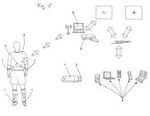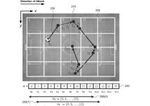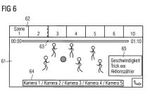Performance control, biometric data collection and match analysis
It is THE trend of recent years, not only in professional sports, but also among recreational athletes, fitness enthusiasts and health-conscious people: the measurement and collection of biometric data. From simple pedometers, smart watches and fitness apps to highly sophisticated monitoring systems for entire teams, all types of sports have fallen prey to complete digital collection in recent years. The performance measurement, which has always played a central role in sport, has been raised to a completely new level thanks to numerous new developments. Joggers post their laps and times on social networks, climbers share their routes and heart rate data on the Net, football coaches can monitor every heartbeat and step of their players.
Collecting biometric data: Some examples
We would like to present just a few examples of the wide variety of new technical developments for collecting biometric data of athletes:
Most methods involve placing a recording device directly on the player.
"Method for detecting biometric data of e.g. sportsmen" (DE 10 2008 049 380 A1) provides for a measurement recorder that detects spatial movements, such as a 3D acceleration sensor, a 3D magneto-sensitive sensor or a 3D gyroscope. A buffer collects the data and sends them with an individual ID code to a central server, which analyses them according to predefined parameters. This method is said to be capable of detecting, among other things, every movement of all body parts, the maximum final acceleration of a football or various movement patterns such as dribbling.
Thus, it not only helps the coach to accurately assess the performance of individual players or to analyse the playing behaviour of an entire team, but it also claims that it can reproduce scenes of famous football matches in detail and true to life, for example in PC games. According to the application, the analysis data of individual players can also be displayed live on the scoreboard in the stadium.
DE 10 2016 102 083 A1 uses a similar principle: An inertial measuring unit is carried on a hip belt and comprises an acceleration sensor, a rotation rate sensor, a GNSS sensor and a sensor for magnetic fields. It allows to provide, for example, a graphic display of the movement of the players on a screen in order to watch their interaction with each other and, based on this, derive a match strategy.
The "wearable sports monitoring equipment and method for characterizing sports performances or sportspersons" (DE 10 2015 120 044 A1) also operates with various sensors, but also with an algorithm that can relate the heartbeat signal, for example under full physical strain, to the characteristics of other periodic situations.
The "apparatus device and method for mobile determination of a physiological stress threshold value" (DE 10 2013 211 908 A1) measures the respired air volume. The sensor "based on the principle of respiratory inductive plethysmography" is integrated in the jersey so that it cannot slip out of place and delivers more reliable measurement results.
Other systems (e.g. DE 10 2015 003 383 A1) hide the sensors in the shin guard.
EP 2 370 186 B1, however, aims to equip both the football and the players? boots with force and inertial sensors, to combine the data and to generate player- and team-related statistics and metrics.
Nevertheless, equipment worn on the body can hinder the athlete or be very easily damaged in contact sports such as football. That is why the "active status measuring device" (DE 10 2016 108 691 A1) takes a different approach: Wireless vital sensors for capturing biometric data of individuals are installed at predetermined setting locations, somewhere at the edge of the pitch. The sensors are configured to sense the biometric data of a mobile individual when the individual enters their sensing area. This identification sensor works with RFID data.
"Characterizing motion patterns of one or more agents from spatiotemporal data" (US 9 740 984 B2) works completely without sensors: It describes a game analysis and computation of metrics based on the analysis of moving images of an entire team using image data processing methods applying modelling of motion patterns and statistical methods.
| Publikationsnummer | Jahr | Titel | Kurzbeschreibung |
|---|
Match analysis
Since the 1990s, it has become increasingly common to collect a wide range of data relating to a football match: first shots and chances on goal, then possession of the ball, mileage, balls won and much more. Initially, these parameters had to be laboriously recorded manually, but soon numerous new developments helped in data collection.
Here are some recent examples:
"Tracking activities of events" (WO 2016 / 087 713 A1) helps to record game events: Ball possession, passes, etc. can be entered by means of touch gestures, player names by means of microphone. The creation of heat maps and data evaluation is also made easier.
If one wants to analyse certain actions of individual players on film, the "Verfahren zum Verknüpfen von Videobildern einer Person mit einem Ereignis (Procedure for linking video images of a person with an event)" (DE 102015207415 A1) helps: It enables a video summary that is synchronised with data from the sensors worn by athletes. This allows desired events, e.g. a player's shots, to be displayed more quickly.
The Group Performance Monitoring System (US 020170216669 A1) describes a system and procedure for group performance monitoring for trainers. A simplified game analysis promises US 020160379682 A1.
Another electronic analysis procedure describes US 2014 / 0 039 651 A1: Here it is proposed to evaluate and compare individual athletes by analysing their movement patterns, which are detected by sensors in a ball.
A new development for the optimal analysis of video material is proposed by EP 3 270 327 A1: It synchronizes the video images of the playing field with the individual position information of the individual players.
If a quick analysis of the game is required, WO 2015 / 130 773 A1 could be helpful: Here the evaluation of a game for a player, referee or coach is described by combining video data from Augmented Reality glasses (Google Glass) and sensor data from a ball, whereby game scenes can be evaluated and judged either during or after a game.
Match analysis instruments for TV viewers
How would it be if you already knew how a match will end while it is still in progress?
Two new developments can automatically evaluate game progressions and predict results:
"System for interactive sport analytics" (WO 2017 / 106 390 A1) is a computer-aided game analysis that aims to establish the similarity to the course of the game from a historical database and can be controlled by the spectator in order to also display probabilities for the further course of the game.
"System and method for assessing or predicting a match outcome" (WO 2015 / 076 682 A1) enables a match analysis that is also based on historical data and attempts to draw appropriate conclusions in order to predict the probable outcome of a football match before the end.
Hot fight or lame game? ?Generating excitement levels for live performances" (US 2014 / 0 067 939 A1) describes a particularly interesting analysis idea for football fans in front of the television: If you watch football matches not live but with a time delay, you don't want to know the results in advance, but would like to know whether it is worth watching them at all. Therefore it is proposed here to calculate appropriate metrics describing the tension and the entertainment value and to make this information available to the viewer.
Such an instrument could be particularly attractive at a World Cup with its numerous matches, which one cannot and does not always want to see all of them!

![]() System and method of penalty data compilation, analysis and report generation (US 2014 / 0 244 696 A1)
System and method of penalty data compilation, analysis and report generation (US 2014 / 0 244 696 A1)
That was a clear foul, that was! Every football fan knows it, this urgent need to give the referee a real opinion and comment on his whistles. ?System and method of penalty data compilation, analysis and report generation" (US 2014 / 0 244 696 A1) is just right for the job: A platform is proposed here where the referees and their decisions can be judged and evaluated on the basis of game scenes (video sequences).
But the dream of every fan is to be able to intervene in the game. Under the sober title "Verfahren, Vorrichtung und Computerprodukt (Method, apparatus and computer product)" (WO 2014 / 177 225 A1) a possibility of participation of fans and spectators is described: At certain game events, real-time opinion polls can be conducted, for example to determine who should take a penalty kick. The only question is whether the manager would listen to it...
| Publikationsnummer | Jahr | Titel | Kurzbeschreibung |
|---|
Injuries
To go boldly where it may hurt: Football is a tough sport with a high risk of injury. Several quick tests have recently been developed to provide a rapid diagnosis of an injury or to provide information about possible health problems.
The patent documents can be divided into 3 groups: the measurement of the antioxidative protection of the body, the determination of brain injuries using quick tests in body fluids and the determination of articular cartilage damage using a quick test in body fluids.
US 020170059549 A1 is used to measure the oxidation-reduction potential of an athlete in body fluid samples to avoid states of exhaustion that are hazardous to health.
DE 102012003595 A1 also describes a "procedure and testing utensils for the patient-oriented assessment of the state of antioxidative protection against oxidative stress in the organism".
Brain concussions are not uncommon in football. Recently, numerous blood tests have been developed to predict the individual risk of suffering late effects after a mild concussion (e.g. WO 002016160742 A1, WO 002018005791 A1; WO 002016166419 A1). These tests are simpler than conventional imaging methods.
Blood tests were also developed for another unpleasant, serious injury, such as the "procedure for detecting denaturation or damage to articular cartilage" (EP 000002128615 B1).
In general, these methods are not specific to football and are generally used by athletes who perform well or are exposed to a certain risk of injury, especially in the head area.



